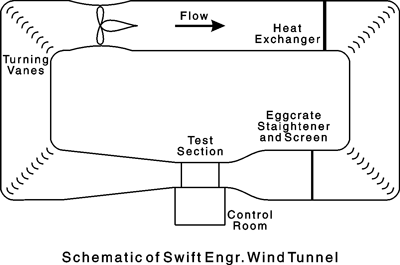INSIDE
RACING
T E C H N O L O G Y
IRT Home
IRT Home
News Page
Contents Page
Newsletter &
Books
email Paul
The Underwing and Diffuser
This is an excerpt from Inside Racing Technology.
Swift Wind Tunnel
There is only one state-of-the-art racecar wind tunnel in this country and it's at Swift Engineering in San Clemente, Calif., an hour south of Los Angeles. [That's not true since Reynard built a new wind tunnel in Indianapolis.] Late in 1992, Alex Cross, vice president at Swift, showed me the pair of modern buildings under construction at that time and talked wistfully of the wind tunnel they would put in the smaller of the two. In November of '94 I got to see the finished facility, and it's a stunner.
You recognize the name Swift from the race cars of that name designed by David Bruns. The DB-1 (DB for David Bruns, of course) is the sleek, wide-track Formula Ford that dominated that class for 10 years. Think of that! Bruns sat down and designed a racecar that went totally unchallenged for more than a decade!
Bruns' Sports 2000 car, the DB-2 and later DB-5, were also dominant for almost that long. Formula Atlantic racers know the DB-4 that appeared in 1986 and still wins occasionally in that very competitive class. The DB-3 and DB-6 are Formula Ford 2000 variants of the DB-3 and were also very successful racecars. In the early '90s, Bruns and the other guys at Swift wanted to design a "Big Car" and needed a wind tunnel to do that.
David Bruns would really rather be designing and building
racecars, but instead he's had to plan, design, build, and now
develop a wind tunnel so he can get back to his chosen craft.
"It's like deciding to build a house and then spending two
years making a hammer," he told me. In November of '94,
they were almost there. I spent a day watching them install a
model of a '93 Lola Indy car during the final stages of the calibration
of the facility.
It had been a wet winter in California, and it had rained hard
in the Los Angeles area the day before my visit to Swift. As
a result, the smog had cleared, and you could see a cap of snow
on top of Mt. Baldy, one of the mountains that rim the Los Angeles
basin.
It was about 9 am when I went into the huge building that houses the wind tunnel. Bill King, ex-Goodyear Racing PR guy now working the NASCAR scene with Cotter Communications [Bill is now running my favorite racing website, speedvision.com], met me in the lobby and introduced me to Doug Smyth, the aerodynamicist Swift hired to run the wind tunnel. We went through some offices and then out a door onto the floor inside the building. The tunnel itself looks like a huge heating duct suspended off the cement floor on steel posts. Everything, including the floor, was freshly painted just like in any good race shop.

A wind tunnel is a precision measuring instrument like a fine chronometer, dial caliper, or stellar telescope. This diagram shows some of the basic elements. A 15-foot diameter, five-bladed fan driven by a 500 hp electric motor pushes the air around the circuit. The fan and motor also add heat, so a heat exchanger cools the air to 70 degrees, just like the air conditioner in your home or car. Turning vanes in each corner keep the air from piling up on the outside of the path. A honeycomb flow-straightener followed by a fine-mesh wire screen conditions the air just before the test section. The tunnel narrows right in front of the test section and this accelerates the air from about 30 mph to the 140 mph maximum speed in the test section. The inside dimensions of the flow path vary from a 15-foot diameter tube at the fan to a 19-by-20-foot rectangle at the flow straightener. The length of the full path in the middle of the duct is 318 feet with long sides of 134 feet and short runs about 25 feet on each end. It's big!
Nothing I've described so far is very trick. If you were going
to hang a model airplane in the middle of the test section, you
wouldn't need much more than I've just described, but a car is
different because it rolls on the ground and the air flowing
around and under the car is affected by the ground surface. There's
no use testing a model that doesn't act the same as the real
thing.